 W
WA diuretic is any substance that promotes diuresis, the increased production of urine. This includes forced diuresis. There are several categories of diuretics. All diuretics increase the excretion of water from bodies, although each class does so in a distinct way. Alternatively, an antidiuretic, such as vasopressin, is an agent or drug which reduces the excretion of water in urine.
 W
WAltizide is a thiazide diuretic. In combination with spironolactone it is sold under the brand name of Aldactacine and Aldactazine by Pfizer and other names by other companies.
 W
WAminometradine is a weak diuretic which was used to control oedema in those who suffered mild congestive heart failure.
 W
WAzosemide is a high-ceiling loop diuretic agent that was brought to market in 1981 by Boehringer Mannheim. As of 2015 it was available as a generic in some Asian countries.
 W
WCanrenone, sold under the brand names Contaren, Luvion, Phanurane, and Spiroletan, is a steroidal antimineralocorticoid of the spirolactone group related to spironolactone which is used as a diuretic in Europe, including in Italy and Belgium. It is also an important active metabolite of spironolactone, and partially accounts for its therapeutic effects.
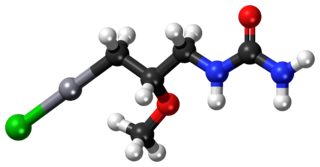 W
WChlormerodrin is a mercurial diuretic that was once used to treat patients with heart failure, but is no longer used in the United States.
 W
WChlortalidone, also known as chlorthalidone, is a diuretic medication used to treat high blood pressure, swelling including that due to heart failure, liver failure, and nephrotic syndrome, diabetes insipidus, and renal tubular acidosis. In high blood pressure it is a preferred initial treatment. It is also used to prevent calcium-based kidney stones. It is taken by mouth. Effects generally begin within three hours and last for up to three days.
 W
WCicletanine is a furopyridine low-ceiling diuretic drug, usually used in the treatment of hypertension. The drug is manufactured by Ipsen and marketed by Recordati under the trade name Tenstaten.
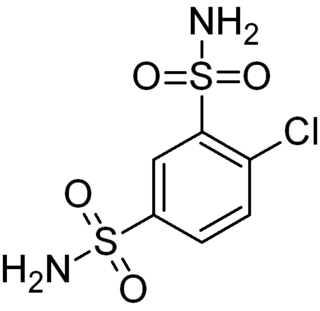 W
WClofenamide is a low-ceiling sulfonamide diuretic.
 W
WClopamide is a piperidine diuretic.
 W
WClorexolone is a low-ceiling sulfonamide diuretic.
 W
WConivaptan, sold under the brand name Vaprisol, is a non-peptide inhibitor of the receptor for anti-diuretic hormone, also called vasopressin. It was approved in 2004 for hyponatremia. The compound was discovered by Astellas and marked in 2006. The drug is now marketed by Cumberland Pharmaceuticals, Inc.
 W
WCyclopenthiazide is a thiazide diuretic used in the treatment of heart failure and hypertension.
 W
WCyclothiazide, sometimes abbreviated CTZ, is a benzothiadiazide (thiazide) diuretic and antihypertensive that was originally introduced in the United States in 1963 by Eli Lilly and was subsequently also marketed in Europe and Japan. Related drugs include diazoxide, hydrochlorothiazide, and chlorothiazide.
 W
WEpitizide is a diuretic. It is often combined with triamterene.
 W
WEthanolamine-O-sulfate (EOS) is an ester of sulfuric acid and ethanolamine. EOS is a GABA transaminase inhibitor which prevents the metabolism of GABA. It is used as a biochemical tool in studies involving GABA.
 W
WEtozolin is a loop diuretic used in Europe.
 W
WGlicaramide (SQ-65993) is an orally bioavailable anti-diabetic medication. It has a similar potency as glibenclamide (glyburide) in the class of medication known as sulfonylureas. Its structure is similar since it has a cyclic acyl group which replaces the latter's 2-methoxy-5-chlorobenzyl. Same as glibenclamide, it is classified as a second-generation sulfonylurea. It may have more pronounced extra-pancreatic effects than glibenclamide or tolbutamide.
 W
WHydrochlorothiazide is a diuretic medication often used to treat high blood pressure and swelling due to fluid build up. Other uses include treating diabetes insipidus and renal tubular acidosis and to decrease the risk of kidney stones in those with a high calcium level in the urine. For high blood pressure it is sometimes considered as a first-line treatment. HCTZ is taken by mouth and may be combined with other blood pressure medications as a single pill to increase effectiveness.
 W
WHydroflumethiazide is a diuretic.
 W
WIndapamide is a thiazide-like diuretic drug generally used in the treatment of hypertension, as well as decompensated heart failure. Combination preparations with perindopril are also available. Thiazide-like diuretics appear to be more effective than the thiazide-type diuretics (hydrochlorothiazide) in reducing risk of major cardiovascular events and heart failure in persons with high blood pressure. In terms of risk of stroke, both thiazide-type and thiazide-like diuretic are effective in reducing it. Both drug classes also appear to have similar rates of adverse effects when compared to other classes of anti-hypertensives.
 W
WIndacrinone is a loop diuretic. It can be used in patients of gout with hypertension as an antihypertensive because it decreases reabsorption of uric acid, while other diuretics increase it.
 W
WMagnesium citrate is a magnesium preparation in salt form with citric acid in a 1:1 ratio. The name "magnesium citrate" is ambiguous and sometimes may refer to other salts such as trimagnesium citrate which has a magnesium:citrate ratio of 3:2.
 W
WMebutizide is a diuretic.
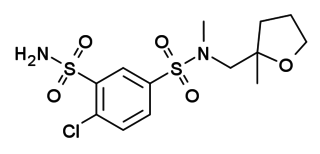 W
WMefruside (INN) is a diuretic indicated for the treatment of edema and hypertension.
 W
WMercurial diuretics are a form of renal diuretic containing mercury.
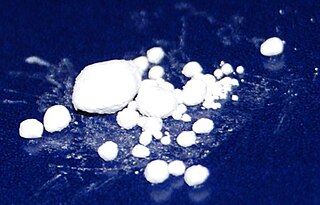 W
WMercury(I) chloride is the chemical compound with the formula Hg2Cl2. Also known as the mineral calomel (a rare mineral) or mercurous chloride, this dense white or yellowish-white, odorless solid is the principal example of a mercury(I) compound. It is a component of reference electrodes in electrochemistry.
 W
WMersalyl (Mersal) is an organomercury compound and mercurial diuretic. It is only rarely used as a drug, having been superseded by diuretic medications that do not contain mercury and are therefore less toxic. It features a Hg(II) centre. Mersalyl was originally adapted from calomel (Hg2Cl2), a diuretic discovered by Paracelsus.
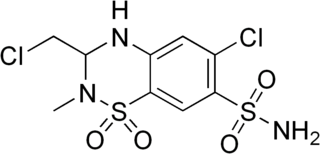 W
WMethyclothiazide is a thiazide diuretic.
 W
WMeticrane (INN) is a diuretic.
 W
WMozavaptan (INN) is a vasopressin receptor antagonist marketed by Otsuka. In Japan, it was approved in October 2006 for hyponatremia caused by syndrome of inappropriate antidiuretic hormone (SIADH) due to ADH producing tumors.
 W
WMuzolimine is a High-ceiling loop diuretic. It is a pyrazole diuretic which was used for treatment of hypertension but was withdrawn worldwide because of severe neurological side effects.
 W
WNiravoline is a chemical compound with the formula C22H25N3O3. It has diuretic and aquaretic effects and has been studied for its potential use for cerebral edema and cirrhosis.
 W
WPamabrom is a product included in retail drugs available in over-the-counter medications. The active diuretic ingredient in pamabrom is 8-bromotheophylline and it also contains aminoisobutanol.
 W
WPiretanide is a loop diuretic compound by using a then-new method for introducing cyclic amine residues in an aromatic nucleus in the presence of other aromatically bonded functional groups. Studies of piretanide in rats and dogs in comparison with other high-ceiling diuretics such as furosemide and bumetanide found a more suitable dose/response rate and a more favourable sodium/potassium excretion ratio. These findings led eventually to studies in man and finally to the introduction as a saluretic and antihypertensive medication in Germany, France, Italy and other countries.
 W
WRolofylline (KW-3902) is an experimental diuretic which acts as a selective adenosine A1 receptor antagonist. It was discovered at NovaCardia, Inc. which was purchased by Merck & Co., Inc. in 2007.
 W
WSatavaptan is a vasopressin-2 receptor antagonist which was investigation by Sanofi-Aventis and was under development for the treatment of hyponatremia. It was also being studied for the treatment of ascites. Development was discontinued in 2009.
 W
WSC-8109 is a steroidal antimineralocorticoid of the spirolactone group which was never marketed. It is a potent antagonist of the mineralocorticoid receptor and is more potent than the related drug SC-5233. However, SC-8109 was found to have relatively low oral bioavailability and potency, though it nonetheless produced a mild diuretic effect in patients with congestive heart failure. Spironolactone, another spirolactone, followed and had both good oral bioavailability and potency, and was the first antimineralocorticoid to be marketed.
 W
WTienilic acid or ticrynafen (USAN) is a loop diuretic drug with uric acid-lowering (uricosuric) action, formerly marketed for the treatment of hypertension. It was approved by FDA on May 2, 1979, and withdrawn in 1982, after case reports in the United States indicated a link between the use of ticrynafen and hepatitis.
 W
WTolvaptan (trade names Samsca, Jinarc, and others) is an aquaretic drug that functions as a selective, competitive vasopressin receptor 2 (V2) antagonist used to treat hyponatremia (low blood sodium levels) associated with congestive heart failure, cirrhosis, and the syndrome of inappropriate antidiuretic hormone (SIADH). Tolvaptan was approved by the U.S. Food and Drug Administration (FDA) on May 19, 2009, and is sold by Otsuka Pharmaceutical Co. under the trade name Samsca. Tolvaptan, as Jynarque, was granted approval for medical use in the United States in April 2018.
 W
WTrichlormethiazide is a diuretic with properties similar to those of hydrochlorothiazide. It is usually administered for the treatment of oedema and hypertension. In veterinary medicine, trichlormethiazide can be combined with dexamethasone to be used on horses with mild swelling of distal limbs and general bruising.
 W
WTripamide (INN) is a diuretic.
 W
WXipamide is a sulfonamide diuretic drug marketed by Eli Lilly under the trade names Aquaphor and Aquaphoril. It is used for the treatment of oedema and hypertension.